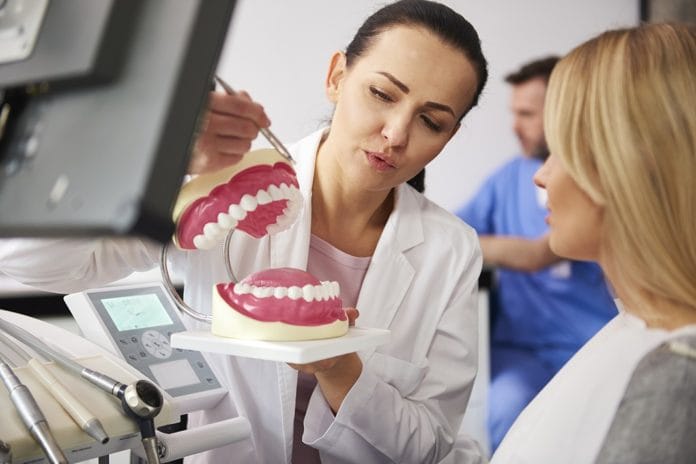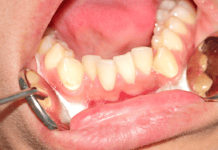Article sponsored by Cetylite. Cherie Wink, RDH was not a paid endorser for this article.
Cetacaine Liquid (Benzocaine 14%, Butamben 2%, Tetracaine HCl 2%), the prescription topical anesthetic from Cetylite, is frequently recommended as a pain control option for procedures such as scaling and root planing. Cetacaine can be placed into periodontal pockets to provide 30 to 60 minutes of needle-free pain control for dental hygiene patients.
How does Cetacaine stack up against other topical anesthetics? Are there other uses that dental hygienists should be aware of during the treatment of their patients? For the answers to these questions, we consulted with Cherie Wink, RDHMP, BS. A dental hygiene instructor, Wink offered her perspective about Cetacaine, based on her teaching experiences at Concorde College in Garden Grove, Calif.
Wink teaches instrumentation, pathology and special needs courses. She has been a hygienist for 28 years, and she is also an appointed assistant research specialist at the Beckman Laser Institute, School of Medicine, University of California, Irvine, where she has had the honor of assisting with various groundbreaking dental research projects.
Today’s RDH: What challenges, if any, were presented by other prescription topical anesthetics that led you to hope that Cetacaine would provide a solution?
Wink: The practice of compounding formulations of topical anesthetics seems to be a growing practice. On more than one occasion, I would show up for work and be introduced to another new, compounded Rx topical anesthetic that the dentist wanted me to use. They would be packaged in a gel or cream consistency, which made subgingival delivery and dosing challenging. After doing some research, I learned that formulation strengths may vary, which could pose a problem for certain patients. Learning that there is a small difference between a therapeutic dose and a potentially harmful one made me quickly reconsider using them.
Today’s RDH: What, if anything, stood out to you about using Cetacaine Liquid?
Wink: Several features stood out to me the first time I used Cetacaine. I was surprised at what a small amount it took to achieve adequate anesthesia within the sulcus or pocket. Additionally, the duration time of 30 to 60 minutes was a welcomed benefit because this provided me plenty of time to complete a scaling procedure without having to reapply additional product.
Today’s RDH: What factors influenced your use of a topical over an injectable anesthetic?
Wink: Convenience and patient acceptance. There will always be certain cases that require traditional nerve blocks via injectable anesthetics. With that said, it seems to make my job a little easier and the patient happier whenever I can provide needle-free anesthesia that really works. I don’t believe I have ever encountered a patient who particularly enjoys receiving injections and their fear of injections is an issue that needs to be addressed so they can comfortably receive the necessary treatment.
Today’s RDH: What treatments do you consider using Cetacaine Liquid for?
Wink: I use Cetacaine liquid for certain types of scaling procedures in the presence of inflammation, use of a diode laser, and localized sites of periodontal probing where the patient has deep pocketing.
Today’s RDH: As a hygiene instructor, how do you advise students when a prescription topical anesthetic makes sense over an injectable?
Wink: We teach our students that it is an ethical responsibility to select the safest agent and most appropriate delivery method for our patients based on their individual needs. We must know the relative toxicity of the agents we use and be vigilant about staying up to date regarding their use. Some examples of criteria which would indicate the selection of a prescription topical over an injectable anesthetic agent include:
- Sensitivity experienced is gingival and not dentinal
- Patient has a fear of needles or injections which may interfere with treatment acceptance or compliance
- Area(s) requiring anesthesia is localized and does not require penetration into oral mucosa greater than 2-3 mm
Today’s RDH: What, if any, differences do you notice when using Cetacaine Liquid vs. other prescription topical anesthetics?
Wink: The liquid consistency combined with the small amount administered means there is no extrusion from the pocket. Therefore, there is no need to rinse or wipe away any excess in the patient’s mouth after application.
Today’s RDH: What if any differences did you notice about the Cetacaine dispensing and dosing system vs. other prescription topical anesthetics you have used?
Wink: Cetacaine allows for adjustable dosing, so the clinician can dispense and use only what is needed while avoiding waste.
Today’s RDH: What if anything did you notice about the viscosity of Cetacaine?
Wink: Unlike a thermogel, which becomes gelatinous or viscous upon contact of the tissues, Cetacaine remains in a liquid form during delivery. This consistency makes it easy to avoid extrusion into the oral cavity, and I don’t have to worry about it traveling or affecting distant sites.
Today’s RDH: What difference, if any, was noted in administering the dosage from the liquid anesthetic in comparison to other prescription topical anesthetics?
Wink: Cetacaine only requires one to two drops per pocket to achieve anesthesia. I can effectively scale an entire quadrant using only 0.2 ml.
Today’s RDH: What did you notice and experience when using the syringe and tip provided in the Cetacaine kit?
Wink: I prefer Cetacaine’s pliable, plastic tip over a rigid metal cannula for subgingival delivery of topical anesthesia for several reasons. It has a smaller diameter, it can be bent to better facilitate interproximal delivery, can be used safely around dental implants, and patients do not mistake it for a stainless-steel needle or injection.
Today’s RDH: Tell me about an experience using Cetacaine? Where was treatment performed? By you or a hygiene student? Why was Cetacaine appropriate for this treatment?
Wink: A patient had come into our clinic after not seeing a dentist in over ten years. When we presented the DH assessment findings and proposed treatment, she began to cry. In a most caring manner, the student gently inquired about her tearfulness. The patient shared that, while she fully understood the seriousness of having the deposits removed from her teeth, she could not bear the idea of having shots in her mouth. She proceeded to share an experience where she fainted after receiving an injection. After ruling out any medical conditions which would be a contraindication, we proposed the use of Cetacaine to anesthetize her soft tissues and nitrous oxide sedation to help calm her nerves and provide additional analgesic effects. She agreed to the treatment and was very grateful. I am happy to report that this patient has been coming routinely to our clinic for over three years now.
Today’s RDH: What is the status of a patient’s numbness by the time he/she is leaving the office after Cetacaine is used in the patient’s treatment?
Wink: The patient’s numbness is usually worn off by the time they leave our clinic. We are a teaching facility, so our appointment duration time is typically two to three hours.
Today’s RDH: What, if anything, do you think your students’ experience with Cetacaine has taught them about the options for using prescription non-injectable anesthetic?
Wink: The students learn that it is important to have a variety of anesthetic products available to best meet the individual needs of a given patient.
Today’s RDH: Are there any particular types of patients you would consider using Cetacaine for? Such as those with medical or physical disadvantages, anxieties, etc.
Wink: Cetacaine has been a problem solver for a wide spectrum of patients with various mental disorders, especially those who suffer from anxiety or any type of apprehension or fear of dentistry. Additional patient types are those who have certain systemic conditions that lead to tremors or other physical disabilities, which would compromise the clinician’s accessibility and/or stability if delivering local injectable anesthetics.
Today’s RDH: What, if any, feedback has been received from patients that you have used Cetacaine on?
Wink: My personal patients, as well as those at the clinic where I teach, all seem to really like Cetacaine. We have even had them come in and ask for “the banana numbing stuff” for chronic areas that cause gingival discomfort when having their teeth cleaned.
Today’s RDH: What is your opinion overall of Cetacaine?
Wink: My overall opinion is that this product is fast and effective for anesthetic needs of the oral soft tissues.
Today’s RDH: Will you continue to use and teach about Cetacaine?
Wink: Absolutely. We have the use of Cetacaine written into the curriculum. The student must pass a competency, which assesses their ability to identify the correct patient case type, load the syringe, and apply Cetacaine correctly. They usually do very well.
Today’s RDH: Why do you feel it’s important that students learn about all the anesthetics, injectable and non-injectable, available to them?
Wink: As a clinician, it is important that we have a variety of anesthetic armamentarium available to us to best meet our patients’ needs.
Today’s RDH: What would you like other hygienists and educators who haven’t used Cetacaine to know about the product?
Wink: I would like them to know how easy it is to use and how little it takes to achieve the numbing effect. It is a wonderful alternative to injecting an anesthetic agent for certain case types.
Important Safety Information
Rx for professional use only. Do not use Cetacaine to treat infants or children younger than 2 years. Do not inject or use in the eyes. Cetacaine is contraindicated in patients who are hypersensitive to any of its ingredients or are known to have cholinesterase deficiencies. Cases of methemoglobinemia have been reported in association with local anesthetic use. Do not exceed maximum dose.
To learn more about Cetacaine, including prescribing and contraindication information check out www.cetylite.com.
Reference
Milgrom, P., Coldwell, S.E., Getz, T., Weinstein, P., Ramsay, D.S. Four dimensions of fear of dental injections. J Am Dent Assoc. 1997 Jun;128(6):756-66.









